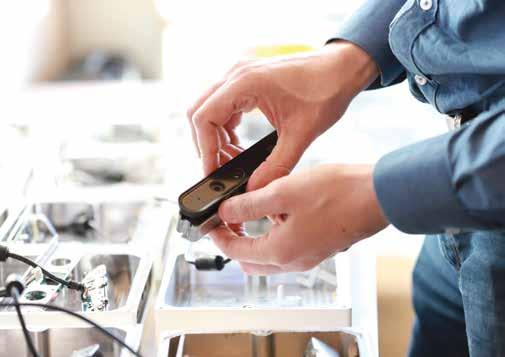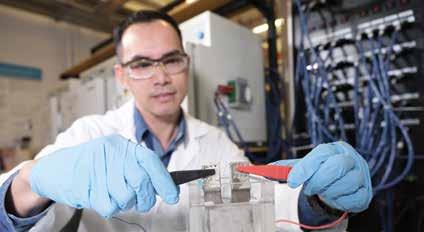
9 minute read
Rail Manufacturing CRC’s legacy
from REX Dec 2019
by Prime Group
How to survive a Digital Tsunami: the Rail Manufacturing CRC’s legacy
A digital revolution is underway in the rail manufacturing industry, says Stuart Thomson, CEO of the Rail Manufacturing Cooperative Research Centre (CRC).
WITH THE GROWTH OF EMERGING technologies which will disrupt the way industry conducts its business, “the changes are going to be rapid and the rail industry needs to be ready,” Rail Manufacturing CRC CEO, Stuart Thomson, tells Rail Express. In response, the Rail Manufacturing CRC has spent the last five years working with the rail industry to start tackling these challenges.
Launched in 2014, the Rail Manufacturing CRC’s focus has been to increase the capability of Australia’s rail manufacturing industry. Industry participants include Downer, CRRC, Knorr-Bremse, Bombardier Transportation Australia, HEC Group, Airlinx and Sydney Trains, who collaborate on research and development programs with institutes such as University of Technology Sydney, CSIRO, Deakin University, University of Queensland, Monash University, CQUniversity, Swinburne, RMIT and CSIRO. “By sharing the risk involved in the development of technology while building networks across the supply chains, this increases the Australian rail sector’s competitive global position and creates a depth of industry capability.”
Since commencing though, there have been some changes in the centre’s focus. Initially focused on heavy-haul, the subsequent plateauing of the mining boom, coupled with massive growth in passenger rail thanks to state and federal investment in rail infrastructure, resulted in a shift in the centre’s focus. While its projects have contributed to a more innovative rail manufacturing industry, the most important contribution of the Rail Manufacturing CRC is the newfound strong engagement between universities and participating rail organisations.
Australia’s universities have highly skilled and worldclass levels of research capabilities, and the challenge lies in the capacity for the rail sector to use that knowledge.
“With less than half of one per cent of scientists and researchers working in rail, it is key to attract and train the next generation of employees, while recognising the new skills that research graduates can bring to Australia’s future rail industry,” Thomson shared. Planning for the future has, so far, consisted of 32 industry projects, 48 PhD scholarships and the involvement of 35 organisations over the entire six-year
life of the Rail Manufacturing CRC, with the centre now working towards a closing date of June 2020. “Over our full six-year lifetime, we will have achieved a wide range of leading research and commercialisation activities across the centre’s program areas of Power and Propulsion; Materials and Manufacturing; and Design, Modelling and Simulation,” says Thomson.
In its Power and Propulsion stream of projects, the centre has focused on energy solutions for better rail efficiencies, looking at battery and supercapacitor development and manufacture, new composite braking materials and rail-wheel-interface projects.
Some of these projects involve the testing of lithium storage technologies. With Australia’s great lithium reserves, this has wide reaching benefit across the resources sector as well as for rail, and according to Thomson, there is a boom in the use of lithium in energy storage devices.
In regard to battery technology, Thomson says the centre is looking at fundamental studies to create better and more efficient lithium batteries, supercapacitors and energy storage systems. The ultimate goal of our energy storage projects is to develop technologies Building camera hardware for use with Dwell Track project with Downer and University of Technology Sydney.
Assessing Bombardier’s axle bearing lubrication needs at the University of Queensland.
Ballast stability projects underway at the University of Wollongong.
that will make overhead rail catenary systems obsolete, resulting in reduced infrastructure and maintenance costs. “We’re working with companies such as Downer, Knorr-Bremse, CRRC, and the HEC Group, all of whom have different applications in a very active field of endeavour.”
“We’re also using energy storage devices for emergency applications in rail as backup batteries. We’re looking at using lithium and new battery technologies to decrease the cost and also increase the life cycle of those devices. Obviously, the less servicing needed means significant cost savings in terms ofmaintenance.” Meanwhile, the Materials and Manufacturing stream of work focusses on component durability, maintenance optimisation, composite material design and assembly automation. The projects in this stream intend to create replacement materials that are much more light weight, yet still with similar or better structural properties and the safety properties required.
“The challenge in rail at the moment is that we’re creating more energy consuming rail rolling stock, so it’s ideal to reduce energy consumption by light-weighting light rail and heavy rail.” Within this, the centre is investigating with Swinburne University, metallic cellular materials, such as recycled aluminium honeycombs and foams for rail sandwich panels. One project is researching the manufacturing methods to best make these materials, while another is looking at experimental works and simulations to investigate the mechanical properties of the sandwich panels.
Another centre project collaboration with the University of Queensland and Bombardier worked to predict the wear rates of axle bearings used in suburban passenger trains. Through the development of a software model, bearing

life is predicted using algorithms that aim to optimise the bearing selection, lubrication and overhaul maintenance schedule with significant economic benefits.
Within the Design, Modelling and Simulation stream, the centre is focussing on passenger information systems and dwell time management, cabin airflow monitoring, data transfer and analytics, and virtual and augmented reality rail training.
One of the more visible of the centre’s projects is the Dwell Track technology created in collaboration with Downer and the University of Technology Sydney. The technology enables operators to anonymously monitor passenger numbers and movement using 3D cameras to extract the relevant spatial and temporal information in real-time.
“We are able to monitor passenger flow and pathways. The information collected is used to better understand how platform infrastructure can be designed and operated in a more efficient way to limit congestion at certain points and times. By understanding where the congestion points are on platforms, operators
are able to redesign or tailor solutions based on the information collected, so it’s really data driven.”
Thomson credits the rail operators for providing the facilities to keep improving the Dwell Track technology. “Queensland Rail, Sydney Trains and PTA Western Australia have all participated in testing and trialling the technology over a number of years. This has enabled the project team to tweak the technology to make it better as we’ve gone along. It is a real example of how operators have come to the fore to assist the development of new innovations,” he said.
While at the moment this technology enables decisions to be made or exceptions to be identified efficiently, Thomson believes this technology will eventually have an artificial intelligence component.
“If we could automate some of those functions, such as if gates can be closed or opened based on computers rather than having staff on the platforms doing that work, we’d be able to free up staff time to concentrate on other critical issues.”
Ultimately, however, the goal is to take the data captured by the technology, analyse it and understand what responses can be taken to alleviate congestions at stations.
When asked about his predictions for the future of innovation in the rail manufacturing space, Thomson says that data analytics is the key. “I think we’re going to see a lot more use of data for modelling and prediction. We’re

seeing a huge focus on condition-based monitoring applications and being able to monitor and understand all components to provide the operators and customers with information relating to the rollingstock’s use and performance in real-time.”
One of the critical uses for this is also to provide maintenance when its needed, rather than in the aftermath of issues. “Being able to predict when something’s going to happen before it does and fixing it prior to breaking down will have huge benefits for operators and manufacturers.”
One example of research being undertaken in this area is a Rail Manufacturing CRC, Deakin University and Downer collaboration to provide data specialists for Downer’s TrainDNA project. Aimed at improving data collection, analysis and interpretation, the team are developing algorithms and system platforms to provide real time information to customers, maintenance staff and engineering specialists. The implementation of TrainDNA is likely to have significant benefits for those who operate and maintain rolling stock.
The growth of new digital systems and data analytics in rail will require an ongoing adaption of the rail workforce. “That’s where we see some of the challenges and the opportunities for rail companies in the future. Building new skill sets into the rail workforce is going to be key to unlocking these digital benefits that can flow into the sector.”
Where previously the skilled workforce in rail was confined to a few specific domains of engineering expertise, a new breed of skilled workforce is now needed. “We no longer primarily need mechanical and electrical engineers, we also need people who can code, we need AI specialists, data scientists, virtual reality specialists, and more.”
As such, the rail sector must be able to attract a whole new digital workforce. “We’re not only competing with other transport providers for specialised blue and white collar workers, we’re also competing with other industry sectors such as finance, mining and tech giants like Google and Amazon,” Thomson said.
“Too often, we focus on the technology, but a lot of the future solutions within the digital field will be expertise driven, they’ll be people-driven. The focus should be on a culture within the industry to build research and innovation capacity, but also to bring the right skill sets and expertise to utilise these new technologies most effectively.”
“The biggest thing we have seen [during the CRC’s six-year term] has been a change in innovation culture. There are very talented young people who need to join the rail industry to propel it forwards, so the focus should be on the next generation of rail workers. I think that we’ve partly contributed to the industry realising that.”
“We’ve got young researchers working on very exciting areas. At Monash University, we have multiple PhD students working on automating systems that can send drones onto tracks, into tunnels and even into the Pilbara region to automatically assess and monitor

railway lines and the integrity ofthose systems.” The main benefits to this are to get people out of danger, off the tracks and out of harsh environments, not only for safety reasons, but also to free them up to do other skilled jobs. “It’s one thing to collect data, that’s the easy part, but it’s another thing to be able to automate, transmit and analyse it instantaneously, in real-time,” Thomson said.
The innovations that the Rail Manufacturing CRC has seen with the rise of the Internet of Things and other such emerging technologies has enabled a whole range of critical information to be captured, such as the integrity of rail infrastructure, the performance of equipment above and below rail, and the capacity to plan for future growth and safe operations of the networks. Upon the completion of its term in June next year, Thomson tells Rail Express that a large part of the Rail Manufacturing CRC’s legacy lies in its initial commitment to collaboration.
“I think we’ve contributed to a realisation that collaboration between researchers and industry is a very good thing,” Thomson said. “The legacy that we’ve created is that collaboration between research organisations and the rail industry is assured.”
And when asked in conclusion how companies in the rail manufacturing space can be more innovative, Thomson is succinct. “It’s simple. Hire, support and trust smart young people.”

Partnership with CSIRO and CRRC to develop supercapacitor technologies.
Showcasing Dwell Track technology at a Sydney demonstration.










